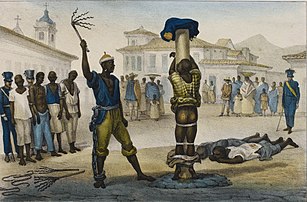Flagellation
The flogging (from the Latin flagellum, "whip") is the act of methodically beating the human body with special implements such as flagella, whips, straps, rods, ropes, etc. Generally flogging is applied against the will of the recipient as a form of corporal punishment; however, it can also be received voluntarily or applied to oneself in religious or sadomasochistic contexts. The lashes are generally directed at the recipient's bare back, although in other contexts they can be applied to other areas of the body. The judicial lashes (penalty of flogging) usually determine a number, or are repeated until the person sentenced to such punishment loses consciousness or dies.
Types of flogging
- Form of physical punishment :
- Azotaina inflicted against slaves by masters.
- Azotaina domestic (practiced as a punishment for parents against their children) or school (practiced by teachers against their students), using the straps, belts, sprues or palmets as whips. With the cultural evolution of some societies, in many countries such punishment has been prohibited, or not tolerated and even considered a crime. In many places in the United States, schools still use corporal punishment under the protection of the law.
- Public punishment in certain Islamic countries, when people do not respect the principles of religion, such as sex outside marriage, consumption of alcoholic beverages, etc.
- Method of torture: practiced to start confessions to the victim during all times and by various institutions.
- Sexual intercourse: part of paraphilia, such as sadism or masochism.
- Religious practice: self-flagelation as a form of meat mortification for religious reasons; for example, that practiced by members of the Christian flogging movement in the 13th century and Muslims (particularly those belonging to chiism) and even some Christian movements today.
History
Flogging has been used at all times and in all ages, although more especially by the Jews. The prisoner suffered it in the Synagogue before three judges and received thirteen lashes with a whip armed with three straps.
In Greece and Rome, scourging was even more atrocious and infamous than flogging and it was only applied to slaves and criminals condemned to die on the cross, very frequently the prisoner died because of the whipping.
In the Catholic Church, flogging was a disciplinary penalty. Among others, Count Raymond of Tolosa was flogged at the foot of the altar for having favored the Albigensians. It was also used as a method of torture by the Inquisition. However, it was more often inflicted as a penance, especially in convents. During the Middle Ages and even up to the 19th century, there were many brotherhoods of disciplinarians who flogged themselves, either in the dark in temples, or publicly in processions.
In tsarist Russia, especially under the reign of Peter the Great, flogging was an atrocious form of death penalty, as it consisted of deliberately killing the criminal with lashes, which did not stop raining on him until he was dead.
Flogging or whipping continued in England and Denmark until the XX century.
Flogging of the Hellespont
It was a ritual punishment of the sea ordered by the Achaemenid king Xerxes I during the Second Medical War.
Flogging of Christ
According to biblical writings, among the tortures to which Jesus Christ was subjected was flogging.
The flagellation of Christ is a very frequent iconographic theme in Christian art.
- The flogging (Piero della Francesca)
- The flogging of Christ (Caravaggio)
It is also very common as an Easter pass:
- Holy Christ of the Hail
- Costume of the Flag (disambiguation)
Erotic flogging
In the 17th century, Johann Heinrich Meibomius, in his book Tractatus de usu flagrorum in re medica et veneria (1639), described the underlying connections between flagellation and eroticism. Between the 18th and 19th centuries, the practice of flogging with erotic implications spread considerably. In Great Britain, erotic flogging became a social phenomenon, from which abundant literature and iconography was generated (Fanny Hill, by John Cleland; A Full and true account of the wonderful mission of Earl Lavender, by John Davidson, etc.). For this reason it is also known as English discipline. In France, erotic flogging became one of the practices most in demand by patrons of Paris brothels around 1900. At the same time, between the XIX and the first decades of the XX, a large number of books focused on erotic flogging were published in France, with specialized authors such as Aimé Van Rod, Jean de Villiot, Jean de Virgans, Jean Fauconney (Jaf and Saldo), among others. The practice of erotic flogging has also been documented in Spain since the XIX century. Throughout the XX century, erotic flogging or English Discipline gradually converged with other related sadomasochistic practices such as bondage or restraints, domination/submission fetishism, etc. being all included within the BDSM.
Contenido relacionado
Botswana flag
Brahma
Alfonso II of Asturias


